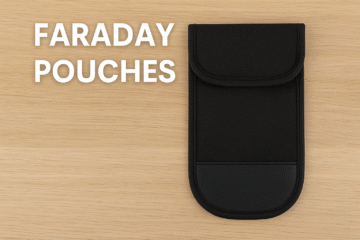Flexible EMF Protection for the Head and Neck
Introduction
With the growing prevalence of wireless signals from cell towers, 5G antennas, Wi-Fi routers, and Bluetooth devices, more people are turning to wearable EMF protection to reduce everyday exposure. Among these tools, the RF shielding head wrap stands out for its comfort, versatility, and effectiveness.
Designed to shield the head, neck, and upper shoulders from radio frequency (RF) and electromagnetic field (EMF) radiation, these wraps combine science-based shielding materials with flexible styling options suitable for both daily wear and sleep.
What Is an RF Shielding Head Wrap?
An RF shielding head wrap (also known as a Faraday head wrap or EMF blocking scarf) is a multi-purpose fabric wrap made from conductive fibers woven into soft, breathable material.
When worn, it creates a partial Faraday barrier that reflects and absorbs electromagnetic energy, preventing it from reaching sensitive parts of the body such as the brain, pineal gland, thyroid, and nervous system.
Because of its soft, adaptive form, the wrap can be styled in numerous ways — as a turban, headband, scarf, or sleep wrap — providing full or partial head coverage as needed.
How RF Shielding Head Wraps Work
RF shielding wraps use conductive materials like silver, copper, or stainless-steel fibers that interact with electromagnetic waves. The conductive surface redirects and neutralizes incoming radiation, significantly lowering the field intensity around the wearer’s head.
Core Mechanisms
- Reflection: RF waves are reflected away from the body.
- Absorption: Some frequencies are absorbed and converted into harmless heat.
- Coverage: Flexible design ensures shielding of the scalp, temples, and neck, where exposure is often highest.
Most RF wraps achieve 40–80 dB attenuation, blocking up to 99.99% of wireless signals across frequencies used by Wi-Fi, Bluetooth, and 5G.
Applications and Everyday Uses
1. Sleep and Rest
RF wraps are often used at night to create a low-EMF sleep environment, especially for those who live near routers, smart meters, or urban cell towers.
2. EMF Sensitivity Support
Individuals experiencing electromagnetic hypersensitivity (EHS) report relief from headaches, dizziness, or tingling sensations when wearing shielding head wraps.
3. Travel and Public Spaces
Ideal for airplanes, trains, or city commutes — environments where multiple devices emit overlapping signals. The wrap provides mobile shielding in an elegant, non-technical form.
4. Meditation and Focus
Some users wear head wraps during mindfulness or grounding practices to help reduce environmental noise and encourage deeper focus and calm.
5. Layered Protection
Used with shielding skull caps or scarves, wraps enhance overall EMF protection around the head and upper body.
Common Materials and Performance
| Material | Shielding Rating | Comfort | Notes |
|---|---|---|---|
| Silver Fiber Fabric | 70–90 dB | Ultra-soft | Antimicrobial and conductive |
| Copper-Nickel Blend | 60–80 dB | Medium | Excellent durability |
| Stainless Steel Thread Fabric | 50–70 dB | Moderate | Strong, long-lasting |
| Cotton-Silver Hybrid | 40–60 dB | Very comfortable | Ideal for sleeping and daily wear |
For maximum effectiveness, fabrics are usually double-layered or used in continuous wraps to ensure consistent shielding across the surface.
Popular Brands and Product Examples
Several trusted manufacturers produce RF shielding head wraps and similar protective fabrics:
- DefenderShield® EMF Head Wrap – Silver-threaded bamboo fabric providing up to 99% RF blocking, designed for comfort and breathability.
- Lambs® Faraday Wrap (WaveStopper™ Fabric) – Premium stretch material for all-day wear, offering 90%+ attenuation across Wi-Fi and 5G bands.
- Havnwear® Silver Shield Head Wrap – Elegant wrap designed for both daytime and nighttime use, made from soft bamboo-silver fiber.
- Mission Darkness™ TitanRF Fabric Wrap – Based on TitanRF Flex Faraday Fabric, used in professional-grade RF shielding applications.
- YShield® Silver-Elastic Wrap – Groundable wrap for medical, lab, or personal EMF shielding use.
Advantages and Benefits
- Flexible and multipurpose: Wear as a scarf, turban, or wrap.
- Lightweight and breathable: Comfortable for daily or nighttime use.
- High shielding efficiency: Blocks Wi-Fi, Bluetooth, and cellular radiation.
- Grounding-compatible: Some models can be connected for static discharge.
- Stylish and discreet: Looks like a normal fashion accessory.
Limitations
- Coverage depends on how the wrap is worn — incomplete wrapping reduces effectiveness.
- Shielding weakens slightly with repeated washing or stretching.
- Not a substitute for full-room or structural EMF protection.
- Conductive materials may require delicate handling to maintain performance.
Care and Maintenance
- Hand wash gently with mild, non-chemical detergent.
- Avoid bleach and fabric softeners, which degrade metallic fibers.
- Air dry flat, away from direct sunlight.
- Do not iron or tumble dry.
- Store folded or rolled loosely to preserve fabric integrity.
Proper care ensures long-lasting conductivity and effective shielding.
Who Benefits Most
- EMF-sensitive individuals experiencing symptoms from Wi-Fi and 5G exposure.
- People living in high-signal environments, like apartments or urban areas.
- Anyone seeking better sleep quality through lower nighttime EMF levels.
- Wellness-focused individuals using grounding or EMF minimization practices.
Key Takeaways
- RF shielding head wraps offer flexible, wearable EMF and RF protection for the head and neck.
- Made from silver, copper, or stainless-steel fibers, they block up to 99% of wireless radiation.
- Ideal for sleep, travel, meditation, and daily wear.
- Available from trusted brands like DefenderShield, Lambs, Havnwear, YShield, and Mission Darkness.
- Comfortable, versatile, and effective — an accessible addition to personal EMF protection.


